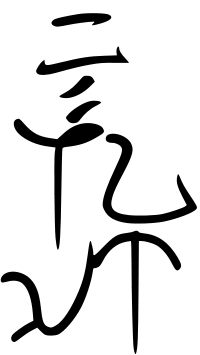Kulitan alphabet
| Kulitan Pamagkulit, Súlat Kapampángan | |
|---|---|
 | |
| Type | |
| Languages | Kapampangan |
Time period | c. 1300–present |
Parent systems | |
Sister systems |
Balinese Batak Baybayin Buhid Javanese Lontara Old Sundanese Rencong Rejang Tagbanwa |
Kulitan is one of various indigenous writing systems in the Philippines. It is used for writing the Kapampangan language spoken in the provinces of Pampanga, Tarlac, Bataan and Nueva Ecija.
Kulitan is an abugida or alphasyllabary writing system, where the consonantal characters possess a default vowel sound that can be altered with use of diacritical marks. Kulitan, like other scripts in Southeast Asia, is an Indian-inspired script.
Structure
The indigenous characters were recorded as culit by the early 17th and 18th century Spanish lexicographers (Benavente, 1699 and Bergaño, 1732)[1][2] and the whole writing system was therefore called kulitan. The ordinary folks simply called them Súlat Kapampángan to distinguish them from the Latin Alphabet script.
Kulitan is basically made up of Indûng Súlat or the "progenitor"(lit. "mother") characters and the Anak Súlat or the "offspring" characters. The Indûng Súlat are the base characters with the unaltered inherent vowel sounds. They are the building blocks of Súlat Kapampángan. Indûng súlat gives birth to Anak Súlat or "offspring" characters whenever their inherent vowel sound has been altered by a ligature or a diacritical mark.
The siuálâ or vowels in Kulitan are usually written as garlit[3] or diacritical marks placed above or below an individual Indûng Súlat or "mother" character. Ligatures are also sometimes used to further lengthen these vowel sounds or represent the monophthongized diphthongs AI (E) and AU (O). A glyph with a diacritical mark or ligature attached to it is an Anak Súlat or "offspring" character.
The recital order of the Indûng Súlat characters are A, I, U, E, O, GA, KA, NGA, TA, DA, NA, LA, SA, MA, PA, BA.[4]
Direction of writing
Historic:![]() , Traditional:
, Traditional:![]() , Modern:
, Modern:![]()
Kulitan is currently the only indigenous script in the Philippines that is written and read vertically from top to bottom and from right to left. Whereas, Surat Mangyan, Hanunóo and Buhid scripts are written vertically from bottom to top and from left to right but read in any orientation.
Handwritten samples and signatures found in 17th century land deeds at the University of Santo Tomas Archives indicate that Kulitan is rarely written vertically,[5] however the written form may have changed during this particular period due to colonial influence. Historic catalogues of pre-colonial Filipino scripts point to a right to left and top to bottom writing direction, as with sister scripts of Tagalog and Tagbanwa.
See also
- Abugida
- Baybayin
- Hangul
- Tibetan alphabet
- Manchu alphabet
- Mongolian script
- Buhid script
- Hanunó'o script
- Tagbanwa alphabet
- Filipino orthography
- Kawi script
References
- ↑ Bergaño, Diego (1732). "Vocabulario de Pampango en Romance y Diccionario de Romance en Pampango". Juan D. Nepomuceno Center for Kapampangan Studies & National Commission for Culture and the Arts, Philippines.
- ↑ Hilario, Zoilo (1962). "Bayung Sunis". Akademyang Kapampangan, Philippines.
- ↑ Pangilinan, Michael (2012). "An introduction to Kulitan, the indigenous Kapampangan script". Center for Kapampangan Studies, Philippines.
- ↑ Miller, Christopher Ray (2011). "Filipino Cultural Heritage in the UST Archives: Baybayin scripts in 17th century land deeds". University of Santo Tomas, Philippines.
External links
- Siuálâ ding Meángûbié on Kulitan: The Indigenous Kapampangan Script
- Nordenx on Súlat Kapampángan: Orthography, Typography, Fonts, and Calligraphy
Font downloads
| ||||||||||